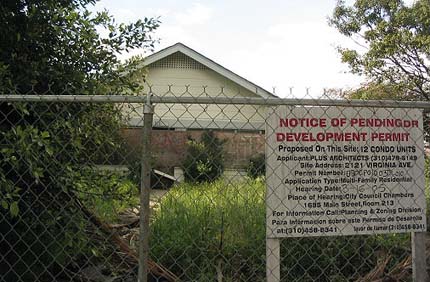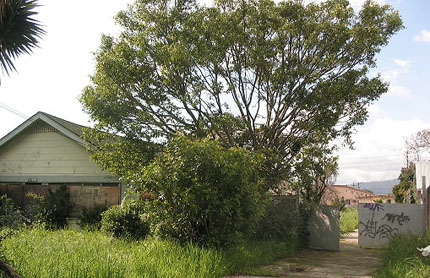| The LookOut columns |

|
What I Say | About
Frank Gruber Email Frank |
|||
|
Who Cares? By Frank Gruber I'm writing this before the car wash, before the haircuts, before the vigil, and before the funerals. I'm too numb and angry to attempt eloquence about the loss of young lives that has plagued our city for 20 years. I'm also too scared -- I have a fifteen-year-old who is partial to his hooded SAMO sweatshirt. So I'll retreat into policy. After last week's column I exchanged emails with a friend who thought I had been too hard on Santa Monicans for Renters' Rights when I linked SMRR's opposition to Macerich's plans for Santa Monica Place to our problems with gangs. He told me that now was not the time, given how everyone was coming together to do something about gangs, to be political. But I don't see the problem as a SMRR or non-SMRR thing, and I don't believe we will solve the problem unless the "rest of" Santa Monica cares about the "other" Santa Monica. Neither "side" in Santa Monica's politics -- neither the ideolog-pols at SMRR nor the local haut bourgeoisie -- have historically cared much about the basic issues affecting poor brown and black people in Santa Monica, which are economic. There's nothing nefarious about this. Politicians can count, and in Santa Monica the number of poor people who vote has never been crucial. For SMRR the past 15 years, since its internal no-growth revolt, addressing the economic issues that matter to poor people -- blue collar and service jobs and investment in their communities -- would have conflicted with the desire of the majority of happy (but perpetually disgruntled) white people in Santa Monica (i.e., the voters) not to be bothered by more traffic. It's been easier for SMRR to promote Community Corporation's diligent but small-scale (1,200 units in 25 years) efforts to provide housing for poor people, and support the living wage, than to adopt economic development policies that might reduce the comfort of the comfortable. SMRR has even had an ambivalent attitude toward Santa Monica College and three SMRR council members voted against fluoridation. As for the city's property owners and business class, both local and corporate, they might care about the Pico Neighborhood in the abstract, but that's not where their businesses are or where they will be (they're too busy making money in the rest of the city), and they definitely don't like that living wage/union thing that might lift people out of working poverty. (But then neglect from both left and right can be better than the alternative -- not long ago the attentions of both do-gooders and capitalists would have led to the bulldozing of Pico to further "slum clearance," "traffic relief" and "urban renewal" -- as happened with the freeway and the Civic Auditorium and in Ocean Park along the beach.) Gangs are endemic to poor people who don't see a way out of their poverty, yet who, politically, cares about ending poverty in Santa Monica? And I don't mean by driving the poor out by or gentrification -- I mean by including poor people in the local economy, by getting them better jobs and by bringing investment to their community. It's what I believe School Board member Oscar de la Torre means when he says, "better neighborhoods, same neighbors." It's not like I've made this up; Mike Davis in City of Quartz made the connection between anti-development "neighborhood protection" and racism, conscious or not. And there is a reason why Pico Neighborhood activists have been trying to increase their influence within SMRR. ("New SMRR Leadership Could Mark Changing of the Guard," March 3, 2005) The bad effect Santa Monica's policies have on the Pico Neighborhood are readily apparent in the case of a proposed development in the Pico Neighborhood that will make its second appearance before the Planning Commission this Wednesday evening. Almost two years ago a developer proposed building twelve condominiums to replace a boarded up, abandoned and graffiti'd house at 2121 Virginia Avenue.
Most cities would throw a banquet for a developer willing to invest millions of dollars to build housing only blocks from the corner, 16th and Michigan, that the city itself declared the epicenter of gang violence, but in Santa Monica, the developer ran into obstacles built into the no-growth system. Because of a combination of Santa Monica's low threshold for discretionary review, Santa Monica's unique standard calling the addition of just one car to a busy street a significant environmental impact, a truly screwy rule on shadows that favors people who fill in their backyards with buildings, the size of the lot, and the fact that commuters use Virginia Avenue as an on-ramp to the freeway, the developers had to undertake a full environmental review. For twelve units. Review that, as no-growth politicians intended, burned up a lot of money and time, and subjected the developers to the tender mercies of the Planning Commission, which heard the matter Nov. 17. ("Commission Views Proposed Pico Condos," November 22, 2004) The project consisted of twelve condos, one fewer than permitted by the zoning on the nearly triple-sized (19,072 sq. feet) lot. No variances were requested. The only environmental impacts identified in the EIR were trivial: a shadow impact that is too complicated to discuss here but which design changes could mitigate, and the addition of 71 car trips a day to Virginia Avenue. Those car trips were the rub. Let's assume that all 71 trips were in daylight hours; that would still equate, on average, to fewer than one car every ten minutes. But because so many commuters already cut through Virginia Avenue, the addition of even one trip would, under the City's unique standard, constitute a "significant impact" under California's environmental law (which allows local governments to apply their own standards). A "significant impact" then requires the City to find "overriding considerations" before approving a project. Before I get into how the Planning Commission handled this, I'll try to put this little development in context. Santa Monica has about 75,000 jobs and 40,000 units of housing, many of which are occupied by retired people. The median house price in California is about $450,000, but there are virtually no houses or condos in Santa Monica available at that price. The whole region has a housing crisis. Middle and working class families have to move to the Antelope Valley and Riverside to buy houses, where they pay $300,000 and up, and spend much of their lives driving -- often to jobs in places like Santa Monica (60,000 inbound commuters). Meanwhile, the Pico Neighborhood is full of hard-working people. Many of them own property in the area, and that property is their most important asset. Others rent. Their children benefit from our good schools and go to college and get good jobs. Let's say one Pico kid goes to Cal State and becomes a teacher in our public schools. Another joins our police force. Let's say they get married and they want to raise a family. Their income will be at least $75,000 -- but what has Santa Monica done to help them buy a home here?
I can only in this space summarize what happened at the Planning Commission November 17, but what transpired was a debate between, on one hand, Commissioners Arlene Hopkins and Julie Lopez Dad, who wanted to reduce the number of units to reduce the number of car trips, and, on the other, Commissioners Gwynne Pugh and Terry O'Day, who considered the city's interest in having more family-friendly housing more important than an infinitesimally small additional delay to be suffered by cut-through commuters. The defining moment to me was when Commissioner Dad said that she would prefer, for traffic reasons, that the project be reduced to a single-family home. That's the same Julie Dad who is president of the Santa Monica Democratic Club and longtime active member of SMRR. I'll file that moment, along with Ms. Dad's comment years ago that no one in Santa Monica would want to work in a Target, under the header, "four legs good, two legs better." Commissioner Jay Johnson ultimately brokered a compromise: the Commission suggested that the developer reduce the number of units to reduce the number of car trips, but not reduce the total number of bedrooms; i.e., the developer would cut the number of two-bedroom units and increase the number of three-bedroom units. And that brings us to Wednesday's meeting. The result of another four months of expensive delay, redesign and uncertainty is that the developer has cut one two-bedroom unit (reducing by 8.3 percent the 71 car trips!) and converted two units to three bedrooms. Which leaves a-whole-nother question about why our codes discourage building three-bedroom units in the first place, but I'll leave that for the future. We'll see what happens Wednesday. But of course, even if the developers pass the Planning Commission, they face another six months or so at the Architectural Review Board. | |||||
Copyright ©1999-2005 surfsantamonica.com. All Rights Reserved. |

